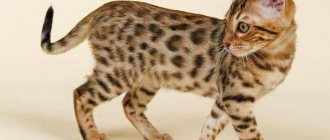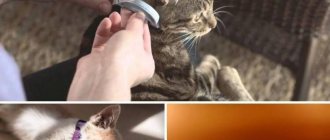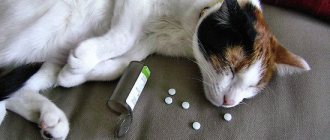Cats differ from people primarily in language and behavior. Of course, you cannot learn to speak the same language with a pet, but everyone can master the basic cat habits. This will allow you not only to better understand your four-legged pets, but also to be able to determine when they have health problems. How to decipher the basic habits of cats? What behavioral features of these animals should be a reason for a visit to the veterinarian?
The cat rubs against people and objects
Representatives of the cat family are also owners. It is important for these animals to have their own territory, which they protect from the encroachments of enemies by all available means. Cat owners also consider their owners their property. Cats rub against them or furnishings to secure ownership of them.
Friction is not a meaningless ritual. With its help, pets leave a special smell on friction objects, which, fortunately, the inhabitants of the home do not feel. Where does it come from? There are special scent glands on the cat's body (face, paws, around the eyes). When an animal rubs against something, they become active - and that something begins to smell. Feeling this smell, the cat calms down and feels confident in its abilities and that the enemy will not encroach on its territory.
The pet rubs against the legs, arms and even sometimes the face of the owner not only to mark him. Friction is one of the ways to show your loved one your tender feelings.
Cat behavior after sterilization and castration
Sterilization and castration are two different operations. Accordingly, after each of them cats behave differently.
A little about the terms
Sterilization is an operation to ligate the fallopian tubes in cats and the seminal ducts in cats (vasectomy). After it, the animal’s genitals remain in place and continue to produce hormones. Under their influence, the pet will still experience hormonal storms. Therefore, he may often experience stress, which is why he shows aggression. In addition, when sterilized, the animal often loses weight because it refuses to eat. It has the ability to mate, but not produce offspring.
Sterilization involves ligation of the fallopian tubes in cats and the seminal ducts in cats
Castration involves complete removal of the genitals. In a cat, these are the ovaries, which are often removed along with the uterus; in a cat, both testicles. Features of behavior - the animal stops marking its territory and screaming.
Cat behavior in the first days after surgery
The first day after sterilization or castration, most cats recover from anesthesia and therefore sleep. Typically, an animal's sleep lasts about 5–6 hours. When it wakes up, it makes several unsuccessful attempts to rise. If your cat manages to get up, be prepared for the fact that at first she will have poor orientation in space, falling and bumping into objects.
On the first day after sterilization, the cat is lethargic
The animal may try to hide, meow and call for help. In the first day or two after sterilization, you need to limit the cat’s interaction with children or other animals, as some pets behave aggressively after anesthesia. If this condition lasts more than 3 days, consult a veterinarian.
When you return home with your animal, wrap it in a warm blanket, since the cat’s body temperature usually drops after anesthesia. Do not place your pet in a place where he can fall (for example, on a chair) - it is better to place him on the floor, on a lounger. Don’t expect that after sterilization the animal will immediately want to eat - try to at least offer it water. By the evening of the second day, the cat should already show interest in food and become active.
Your pet may become aggressive when you touch its belly, and this is normal . However, you will still have to inspect the seams. Typically, 7–10 days after surgery, the animal completely returns to normal life.
Some owners note that after sterilization, their pets become more affectionate and more often ask to be held.
Our behavior changed after castration, well, we have a cat, and this cat really loved the water and began jumping into the bath so that they could play with him in the water.)))
Alekseevna
https://otvet.mail.ru/question/39099147
What does scratching mean?
In general, scratching in cats is often regarded as aggressive behavior. But this does not always indicate the bad character of the animal. If the kitten is small, then this is quite acceptable. After all, this is how he understands the world. Yet these “cute creatures” are predators by nature.
But sometimes even adult cats strive to bite or scold their owner. In this case, your pet has a very highly developed hunting instinct . He perceives your moving legs and arms as “prey.” To satisfy the desire of the “hunter”, purchase special toys for him.
Sometimes curtains and furniture suffer from scratching. Cats don't do this out of spite. When scratched on the surface, they remove old nail scales. And they also keep the paw muscles toned. Damaged furniture and curtains are not pampering for them, but a necessity. Therefore, you should think about buying a scratching post.
A cat buries its excrement so as not to offend anyone
Many people who have cats in their apartment know that after the pet has gone to the toilet, it intensively buries everything. It looks like the cat is performing these actions instinctively, but there is a reason for these actions.
This behavior was inherited by cats from their ancestors. Even before cats were domesticated, they had many dangerous enemies. And so that their enemies would not find them, the cats buried all their tracks.
Also, cats buried everything they did so as not to offend the dominant male of their group. Therefore, by burying their excrement, cats show their owner that they are afraid of him. As soon as the four-legged pet stops doing this, it will mean that he is no longer afraid of you.
Buries food
Burying food is one of the most common habits in cats. Reasons for this behavior:
- Some pets bury food because they like it. This usually happens after changing the usual ready-made food for a new one or after the four-legged pet was offered a self-prepared dish that he had not tried before. Not knowing whether he will have a chance to taste the tasty treat again, the animal tries to hide it so that he can enjoy it again later.
Actions of the owners that can aggravate the situation
The behavior of the owners themselves often significantly reduces their chances of finding a missing cat. They develop tunnel vision and fail to find their pet because they are based on incorrect theories. They try to avoid grief and quickly stop searching. They feel helpless and alone, and others often discourage them from continuing to look by reproaching them and telling them that “it was just a cat” or “you’ll never find your cat.” But one of the biggest mistakes is that all the owners' efforts to find their pet are limited to posting missing cat notices and searching the cages of local shelters. While these methods are important and should not be neglected, the primary method for rehoming a lost cat should be this: Ask your neighbors for permission to enter their yard and personally thoroughly search for your missing cat (and set humane baited traps if necessary). It's not enough to just ask your neighbor to look for your missing cat! Neighbors won't crawl on their bellies under their decks or around their house looking for someone else's missing cat.
Choosing a kitten
The habits of all cats are generally similar. But how can you find out about the character of an animal if it is a small kitten? How to determine who we choose for ourselves?
There is a theory according to which hormones influence their development. They have an effect on both the body and behavior. Therefore, these two factors are connected, which means that the kitten must be selected based on the expression of its face.
When choosing, you also need to pay attention to your parents. Since kittens are constantly with their mother while growing, they have time to learn basic skills.
Scientists have proven that cats - fathers influence habits and preferences even in the embryonic period. Therefore, if possible, take a closer look at your parents.
The breed plays the biggest role in a cat's character. Therefore, first of all, you need to choose a suitable breed. The period of socialization of a kitten takes place in the first four months. All the skills he can acquire will last a lifetime. Therefore, the owner’s task is to teach his pet everything necessary. And in the end, get maximum positive energy and joy from communicating with this independent creature.
Factors influencing cat behavior
All cats behave differently. This is due to many factors:
- character and temperament, which largely depend on the breed. Thus, Siamese cats are jealous and capricious, but Maine Coons are kind, so they are best chosen by families with children. Outbred cats can have very different personalities, because it is not clear from which breeds they originated;
The behavior of a cat depends on the breed, for example, Maine Coons are generally friendly
- education. For a cat to grow up kind and affectionate, you need to talk to it, play with it, and take care of it. And on the contrary, for owners who devote little time to the animal, it can behave vindictively - shit in the slippers and on the bed, etc.;
- socialization. Sociopathic cats do not accept anyone at all (they do not allow themselves to be stroked, do not make contact, etc.), except perhaps the owner when he offers food. It is usually not easy with such animals, but at the same time they do not require much attention;
- trust in people. If you call a cat on the street, he may not come up because he is afraid of humans. This is usually how pets behave. And those who do not have a “roof over their ears” usually run up to be fed, but not all of them either. If a cat has been frequently abused, it may be afraid of everyone around it and not approach a person. Such stressed animals need rehabilitation - they need to be gradually accustomed to normal relationships with humans.
A cat living outside may be scared, which may cause her to not trust humans.
Crushes the owner or upholstered furniture with his paws
Cats mash their owners with their paws because:
- they feel completely safe, just like in childhood, when, as kittens, while feeding, they kneaded their mother’s breasts with their front paws to increase the flow of milk to her nipples;
- they experience true pleasure, and the only way to express gratitude and love to the owner is to sit on his lap and look into his eyes, touching his paws;
- they want to protect a loved one from invisible enemies, leaving odorous marks on him with the help of sweat glands located on the paw pads;
- do therapeutic massage.
These animals crush furniture with their paws to:
- prepare her for bed;
- relieve stress (rhythmic, monotonous movements help them quickly calm down);
- realize sexual instinct during the mating season;
- mark the object of trampling.
The cat is “kneading the dough” again
And very active! Meows, jumps on your lap, purrs, sitting on your lap. Moreover, he “kneads the dough”, which has not been observed for a long time. What is this – an expression of joy from moving? No - this is also a defensive reaction. “Kneading dough” is a behavior inherited by the kitten from distant childhood, when he was close to his mother. The cat is now looking for your sympathy and consolation. We see no reason to refuse an animal such a request! Just “spread some straws” - put on a thick tracksuit or something like that. Your knees shouldn't suffer!
How can you understand your cat by gestures?
Love for animals is a better means of understanding behavioral reactions. I do all of them automatically:
- Nervous twitching or sharp wagging of the tail expresses dissatisfaction;
- raised tail (slightly curved) – good mood and trust in others;
- when frightened or confused, the tail is tucked or fluffed, if the animal is ready to attack another cat or dog (in this regard they are more ferocious), it also hisses with its ears tucked back;
- if the tips of the ears are apart, she is perplexed, raised to the top of the head - a decision has been made, directed forward - interest or recognition of signals.
Sometimes cats scare their owners with their behavior. For example, in complete darkness, when the light comes only from a monitor or gadget, the animal peers at one point with sharply dilating pupils. This does not mean that the cat saw a brownie there (although it is possible); most likely, a spider is descending, the cat is “sharpening.”
Animals are no less emotional than people; they suffer from loneliness in a closed apartment and entertain themselves as best they can. Sometimes they stare at one point for a long time, “freeze”, withdrawing into themselves - the consequences of the stress they have suffered.
Some mark their territory endlessly, others don’t; perhaps they don’t like the smell of a smoky apartment. There are many signs and interpretations of their behavior, so you should not punish the animal. Just try to understand it - look at the world through the eyes of cats.
More familiar smells
Please believe the experience of the author of these lines: the behavior of pets, primarily cats, changes after moving. Sometimes even radical! We understand that in the hustle and bustle, when things are unloaded, it is incredibly difficult to keep track of the cat. And yet, make a note in your memory: the main focus is on your pet(s). If possible, release your cat into the new house or apartment after most of the things have been brought in and arranged. The abundance of familiar smells will certainly alleviate the first stress. And yet, you may not recognize your pet at all. Anything can happen: a previously calm, leisurely cat bristles, rears up, or tries to escape. The sociable animal hides in the farthest corner and does not appear from there for weeks. Something worse also happens: behavioral disorders, increased vocalization, cats refuse to use the litter box and do their business anywhere. Special attention to those who have two or more pets. When moving to a new place, the hierarchy established between them often collapses, wars for leadership flare up with renewed vigor and are often accompanied by fierce fights.
Of course, it is not at all necessary that everything will go according to the pessimistic scenario. Just forewarned means forearmed. The main thing is to minimize the initial stress by surrounding the animal with familiar smells!
Habit of climbing higher
The habit of climbing on high objects (not every cat has this feature) has 2 justifications:
- Felines do this to realize the territorial feeling inherent in nature. These animals adhere to a hierarchical model of relationships. The owner of the territory climbs to a height - this way he can take in all his possessions with his gaze, which allows him to control the situation and, if necessary, descend, subjugating other relatives or entering into battle with them.
- Cats climb to heights because they feel in danger, which comes, for example, from a dog.
The cat is sick
Of course, the cat can get sick. And diseases in the cat tribe are often the same as in people. The cat has a cold and her ears hurt. She shakes her head and tries to get her paw into her ears. He even puts out his claws and scratches his skin a little. She may have diabetes, inflammation of the lungs and urinary tract, heart disease, or a tummy ache. You definitely need to show her to a veterinarian and treat her following his advice.
It is necessary to select food for your cat very carefully, since cats are, in fact, very picky animals. Read about cat feeding options here Cat Nutrition. But under no circumstances overfeed your cat. Obesity will not bring her health.
Just like people, when they are sick, a cat becomes moody when sick. Her character and habits change. And after recovery, these changes that upset you may remain. Only your tactful behavior can help return your cat to good old habits.
It was painful for her to go to the toilet and she stopped sitting on the tray, because now she associates the tray with illness. But when she was sick, she wanted to drink a lot. As a result, puddles left anywhere but in the tray increased in size. And your mood worsened. It seemed that by punishing the cat, you could force it to remain neat as before. But the cat, in response, began to be mischievous and even bite. Try moving the tray to a different place for a while and changing the filler so that her toilet reminds her of her illness as little as possible.
Why do cats hiss when they sense danger?
Many people have repeatedly witnessed “cat fights.” When a cat attacks an enemy, it presses itself to the floor, lowers its ears and emits a terrible hiss. This is explained by the fact that cats are able to imitate and imitate various sounds. Therefore, smart animals chose to imitate a creature that they are practically afraid of - a poisonous snake. The cunning cat's brain understands that hissing is intuitively associated with a snake. That is why, in order to scare the enemy, the cat hisses.
Cats can imitate small children
All cats “communicate” with their owner with a characteristic meow. When a cat meows, it wants to say something to a person, for example: “Feed me!”, “Pay attention to me!”, “I did something, go clean it up!”
When communicating, cats use different tones and different levels of “volume” of their sounds. Few people know, but with the help of these sounds cats manipulate their owners.
Research by scientists has shown that the cry of a hungry cat, in frequency, resembles the cry of a hungry baby. This is surprising, because this discovery showed that this phenomenon is not just a coincidence. And the real “cunning” of four-legged fluffies. Over the years, cats have learned to use the frequency of sound that people respond to faster. But you must admit that these sounds do not irritate you, but evoke natural instincts, which prompt you to go and feed the cat. Incredible, right?
Love for drawers, boxes and cabinets
What does it mean that cats love boxes, drawers and cabinets and have an irresistible desire to hide in them? This feature is explained by the desire for privacy. This habit was passed on to modern pets from their wild ancestors, who were forced to live in harsh conditions, sometimes hiding in secluded places from the predatory animals that hunted them.
In a residential area, cats are not in danger of becoming victims of an enemy, unless we are talking about them living in the same territory with dogs with whom they do not have a good relationship. However, they retained the habit of hiding in secluded places.
Cats that spend all their time indoors
For a cat that spends all its time indoors, its territory is the home in which it lives. When such a cat runs outside, it immediately finds itself in unfamiliar territory. Usually in such situations they look for the nearest place that can provide them with shelter and protection. Their instinctive reaction to what is happening is to hide, because for cats this is the main method of protection from predators. How long they will stay in this shelter and what they will do then directly depends on their temperament. The key question to answer when a cat that spends all its time indoors runs outside is: “Where is the cat hiding?”
Description of the Scottish Straight cat
Scottish cats differ in a number of characteristic features that are unique to this breed. Sometimes animals are often confused with the British species, but during the comparison process the following differences can be identified:
- more rounded head;
- the body has an oblong and elongated shape, which gives the animal elegance;
- body proportions are slightly reduced;
- the average weight of a cat is 3 - 5 kg, boys weigh slightly more than females;
- pets are very flexible and remain hardy and playful at any age.
The cat brings caught mice, birds and even rats - dead and half-dead
If a cat brings caught rodents and birds to the owner, most likely, in this way she shows maternal feelings when all her forces are aimed at finding food for the cubs. Some animals, with the help of such an original gift, which seems quite appropriate to them, show their owners their tender feelings or gratitude.
Another reason for this behavior is the animal’s desire to teach its owner hunting skills. For this purpose, the pet does not bring killed, but only strangled mice and birds.
Medical problems. (Maybe the cat is sick. Or maybe she’s sad?)
Do you love her as much as she does? What do you know about cats and their habits? A healthy cat quickly gets used to the place where it will live. She knows where the tray is. And with all her desire to mark the place where she lives, she will not do this either in the corridor, or in the rooms, or near her favorite chair, or in the kitchen. She respects her owners, understands and feels them. Having carefully eaten from her dishes, she will definitely go to the toilet on a tray that you have carefully cleaned. And he will sharpen his nails on a specially prepared piece of wood or a convenient scratching post. And, if the cat is sick or you are doing something wrong, from her point of view... Then you need to show more participation and attention to your little friend. Perhaps by observing her, you will understand the reason for the strange behavior. For example, check if your kitty is sick?
Places itself to rest in the most inappropriate places (aisles, on the keyboard, etc.)
Pets sometimes disturb the inhabitants of the home, resting in the passages, occupying the space near interior doors and computer keyboards. Is there any special meaning to this behavior? The tendency of cats to settle in inappropriate places can be explained by the desire to mark boundaries.
Representatives of this family consider the territory on which they live, as well as everything that is on it, to be theirs. By being located in doorways, they demonstrate to the inhabitants of the home, including other animals, that it belongs to them. In addition, by staying in the passages, cats try to cool themselves, since it is in such places that air circulates best in the house. They usually behave this way in the warm season or if the home is too hot.
Perhaps this behavior is also due to the fact that the pet, clearly disturbing the inhabitants of the house, is trying to attract attention to itself in such a simple way. Indeed, it’s hard not to notice the cat, which is sitting imposingly on the keyboard. You shouldn't chase him away. It is better to take your four-legged pet in your arms and spend some time with it.
Live like a cat! 12 rules you should learn from them
Cats have an innate ability to enjoy life, while we need to learn this. Stefan Garnier observed his cat Ziggy for twelve years, and then collected all his observations in the book “Live Like a Cat.” In it, he tried to decipher the cat's habits, habits and characteristics. And he invites you to study their simple secrets in order to escape from everyday worries, regain mental well-being and smile.
The life philosophy of cats is very simple: eat, play, sleep and do what they like. In fact, it is not much different from ours. But only at first glance. Let's learn to appreciate life like they do. Imagine that from today you think and live like a cat.
- Your cat is free. We tend to shackle ourselves hand and foot: with bank loans that force us to work more and more; useless things around which we build a cult; habits that become our responsibilities; people with opposing views.
Do you want to live like your cat? Be free as air and do only what you think is necessary. Why not try to keep only what we love in our lives. Maintain only those relationships that suit us. Do only those things that we like. And do only the work that brings us satisfaction.
- Your cat is charismatic. Cats don't need to meow, rush back and forth, or make a cacophonous noise to get attention. They have such a strong charisma that their presence is immediately felt as soon as they appear in the room. Who doesn't dream of possessing such magnetism? Your cat just is!
Charisma develops when we are honest with ourselves and others and accept ourselves as we are, without hiding our individuality behind tricks.
- Your cat is calm (most of the time). What we call stress in cats is actually increased vigilance and wariness. When potential danger arises, the cat raises its ears, focuses its eyes, watches and waits, but as soon as the danger has passed, it immediately calms down.
Cats don't push themselves like we do. They lead a measured and contemplative life. To maintain peace of mind and well-being, identify the source of stress, solve the problem and forget about it.
- Your cat knows how to stand up for himself. Due to excessive shyness or lack of self-confidence, we cannot always stand up for ourselves. We hesitate, we are afraid to say too much.
Try stepping on your cat's paw and see his reaction. He will let out a heart-rending scream, and perhaps even grab your ankle.
Cats do not claim someone else’s territory, but they also do not tolerate encroachments on their own. Know how to stand up for yourself and stop any attempts to invade your personal space!
- Your cat is wise. With its attentive attitude and ability to listen, the cat resembles a Buddhist teacher or an old sage. But perhaps this is more than just an impression. Maybe we should learn from cats the ability to sit quietly and contemplate what is happening, avoiding vain self-expression.
Sometimes we get too focused on something, forgetting about the main thing: why we came into this world. Perhaps this is exactly what the cat is trying to remind us of with its peace and contemplation.
- Your cat accepts and loves himself for who he is. Does a cat dream of being some other cat or even another animal? Hardly! Cats are proud to be themselves, and this shows in their arrogant attitude towards other animals and even towards people.
- Your cat doesn't care about public opinion. Cats do not feel the need for universal love, approval and admiration. They just are. For them, only their own opinion about themselves is important. Of course, it is impossible to live in society and be free from society, but sometimes there is a clear imbalance between self-esteem and public opinion.
Cats never copy the habits or behavior of their relatives. They remain true to themselves, their desires, character and needs, not wanting to fit into any framework in order to correspond to something or someone.
- Your cat is curious. As soon as he gets out of his basket, he starts poking his nose everywhere. This curiosity is limitless. It forces them to constantly explore their world and make new discoveries every day.
Be amazed! Your life will become brighter and more interesting! One act of curiosity a day means 365 new pieces a year to fill your life.
- Your cat is independent. Why do cats lead such an independent existence? They simply do not make excuses for anything and are guided only by their own motives - without external pressure, social obligations or a guilty look. This unquestioned independence is the key to the freedom of any feline.
- Your cat loves peace and quiet. We live in constant noise that gets on our nerves: roaring cars, slamming doors, cell phone ringtones, notification messages, and so on. And cats love peace and look for it everywhere. External peace feeds the inner.
- Your cat knows how to say “no” (and does it readily). Stubborn to the core, cats rarely do what they're told. Stop satisfying other people's needs and following directions that don't suit you.
- Your cat feeds on love. Cats are not “ashamed” to come up and demand their “portion” of affection and tenderness.
Each of us has our own need for love and our own daily dose of this elixir. But we all need tenderness, hugs and warmth. We take love from our partner and from our cat, just as the cat takes it from us. Remember how he gently rubs against your legs or lies under your side. So he is fueled by your love, overjoyed with happiness and satisfying his need for affection. And “having charged the battery”, it jumps from your hands and goes about its business. Love and be loved.
There is some magic in the ability of cats to remain calm and look happy in any situation. Live like your cat! Learn to let go of everything unnecessary, focus on what is important and take care of your well-being.
Harmful cat habits
Not all cat habits are liked by owners; some habits create difficulties for people keeping a pet in an apartment:
Scratching furniture
Sharpening their claws is a natural need, this is how animals remove excess length and clean off the stratum corneum. It is necessary to install a scratching post and teach the cat to use it, strictly preventing attempts to tear up furniture, wallpaper, carpets, and floor coverings.
Tags
Sexually mature cats leave fragrant business cards on the corners of walls, legs of tables, and cabinets. This is how they indicate their right to territory and declare to females that they are ready to mate.
The acrid smell of the secretion is difficult to evaporate, absorbing into the surface. To avoid an unpleasant spirit in the house, to save yourself from unnecessary suffering, and the animal from illness, attempts to break free, it is recommended to castrate the cat. Especially if the owners do not plan to engage in breeding.
Eating out
Cats walking outside on their own can eat offerings from compassionate passers-by and food waste. Stale food causes poisoning, infectious diseases, indigestion, and vomiting. Particularly dangerous are the linings of “cathunters” stuffed with crushed glass and the points of fishing hooks.
Be sure to read:
How to scare cats away so that they don’t shit, mark and damage furniture, what smell they can’t stand
Utility companies leave out poisonous food to kill rats, but cats can also fall prey to coumarin. It is necessary to feed your pet well before leaving, and it is better to prevent self-walking.
Talkativeness
Intrusive meowing can be irritating for some owners. In this way, the cat signals hunger, fear, anxiety, and pain. Increased talkativeness is unusual for cats; once you figure out the reason, the animal immediately stops talking.
Keeping cats is a fascinating process; intelligent animals adopt the atmosphere of the house and their owners. It's funny to watch them play, fuss with children or other pets, and develop their character as they grow older. Some cat habits have become an inexhaustible source of memes, jokes, and funny videos. Share in the comments which pet habits you like and which you don’t?
Behavior algorithms
How friendly a cat will accept a stranger is determined by the following factors:
- cat breed;
- character, temperament;
- gender differences;
- age.
The cat breeds with close wild roots are the most difficult to get along with their fellow tribesmen: Bengal, Savannah, Safari, Caraquet. Such animals are bred at the same time.
Cats of the Persian and Siamese breeds show aggressiveness at first, but then get used to the opponent. Abyssinian, Burmese, Siberian breeds have difficulty accepting competitors. It is better to get a second pet while the animals are young.
Russian Blues, Nibelungs, and Ragdolls are flexible and friendly towards new residents. Sphinxes, exotics, and rexes are distrustful and have difficulty accepting changes.
When buying two animals at the same time, in an unfamiliar environment, it is easy to make friends with them.
Elderly cats over seven years old have a hard time accepting the appearance of a stranger: they become depressed and can become seriously ill.
Newcomers of the opposite sex, younger and smaller than the resident, settle in more easily.
There's a cat living in the house
To make a playmate for your furry pet, the following rules will help you make friends:
- You cannot get a pet when the cat is pregnant or nursing kittens. The exception is a kitten, which the cat will raise along with her kittens.
- During estrus, the female is excited and aggressive, and the appearance of a stranger will be met with protest.
- Older cats are sensitive to newcomers.
- Young individuals bond more easily.
Cats are strongly attached to the house and consider the apartment to be their nest. They fiercely defend their rights, and gradually accept the second individual. Over time, animals are able to make friends. The old cat usually dominates.
A cat that appears in a house with a cat will quickly become friends with it. The result will be mating and offspring, regular pregnancies. It is better to neuter one of their animals. Surgery on a male is easier. Experienced breeders do not keep a pair of fertile individuals of different sexes together.
If the cat is sterilized, the appearance of a fertile male causes a protest: the cat hisses and can scratch or hit with its paw.
A kitten up to 6 months will be adopted by the cat, following maternal instinct, she will take it under her care. It is possible that when the kitten grows up, problems will arise between friends.
There's a cat living in the house
The appearance of a kitten when an adult cat lives in the apartment is rarely perceived with friendliness. Males do not have the instinct to care for offspring; the cat will ignore the baby. If his territory is encroached upon, he may hit him with his paw, but will not fight seriously.
Do not pair a kitten under 3 months with an adult cat, it can choke it.
It's difficult for two cats to get along in the same house. Competition in everything: for territory, affection of the owner, food, the best place to relax. An active male will oppress a weak one. Confrontation leads to stress and weakened immunity. The solution is castration of one or both individuals, keeping them in separate rooms or enclosures.
The cat accepts the female in a friendly manner, neighbors can easily become friends. A fertile male shows interest in an individual of the opposite sex; a castrated male is friends with a cat due to the preservation of the reflex functions of the body. It is important to feed separately. The cat, proving its dominant position, deprives the pet of the necessary calories.
Sometimes he curls up into a ball, sometimes he stretches out in his sleep.
Curling up in their sleep is a typical behavior for many cats. It is not difficult to understand why they choose this particular position. Curling up into a ball, tucking their paws under them and wrapping their tail, they just want to keep warm. Animals usually sleep this way in the cold season and when the house is cool.
Another reason for this position in sleep is to protect the internal organs from a possible attack by the enemy. Modern representatives of this family inherited this feature from their wild ancestors, who, even in a sleepy state, were on alert so as not to become prey to predatory animals. Pets are not in danger, but they still sleep curled up in a ball.
Sleeping animals periodically stretch out to stretch their stiff bones. This position indicates that the four-legged pet feels completely safe. Cats sleep in the same position when they are hot.
How to protect yourself
Friends, I want to remind you that cats are descendants of wild animals and are guided by instincts. Sometimes even pets we know well behave unpredictably. If you see that the cat is aggressive and is not in the mood to get closer, do not provoke it! Leave the animal in the room and wait out this moment. You might find my article on how to calm a cat useful.
To protect yourself from scratches and wounds, wear thick clothing with long sleeves. If you go to tame a street dweller, it doesn’t hurt to wear gloves and take with you regular cardboard, which you can use to scare away the cat (with noise and sudden movement) if something goes wrong. Stay away from wild animals. If they need help, call animal control or contact volunteers.
After contact with street cats, disinfect your hands.
Features of behavior, when they appear, you need to take your cat to the veterinarian
It is recommended to show your pet to a veterinarian if he:
- Tucks tail to stomach, trembling and spending most of the time lying down. This may indicate the development of diabetes or spinal problems.
- He behaves nervously, constantly licks himself, his tail muscles twitch.
- Constantly snorts and rubs his nose with his paws, which may indicate a runny nose, sinusitis, inflammation of the tooth root, or a foreign body getting into the nasal passages.
- He hides and avoids communication in every possible way or, on the contrary, persistently tries to climb into his arms.
- Shows unmotivated aggression.
- Doesn't allow anyone to touch him.
- Meows constantly.
- He hits the wall with his head, freezing in this position.
- Moves sideways, backs away, crawls away, clinging to the floor.
Share with friends!











